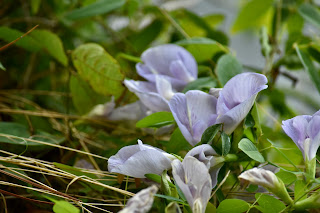Our hike began at the Champion trail, which starts at the West end of the Lodge parking lot. (1 mile; Elevation: 566.76 ft./628.17 ft.)
Today at 10 A.M., we went on a Paw Paw Patch hike led by Sam Woodruff. A family of five, consisting of two girls and one boy, lived and traveled in a fifth wheel, exploring the USA. He was ex-military. A woman from Florence got too hot while hiking. Everyone stopped hiking while Sam went to get a golf cart and take the woman to her car. He made sure she was okay before leaving her. We then continued our hike.
We saw many different wild mushrooms, wild flowers, and a couple of ripe pawpaws. The littleredheaded boy found a rubber snake in a tree. Sam said he had placed several along the trail on a previous hike for schoolchildren to find.
Sam identified several mushrooms and plants on the hike.
 |
Seeds from the Paw Paw Patch
One of the most delicious late-season rewards for hikers and wildlife alike is the pawpaw fruit, which begins to ripen in late summer and reaches its peak in September and October. The flavor of pawpaw fruit is often compared to bananas but with hints of mango, vanilla, and citrus. The fruit has an ungainly appearance, resembling a small green potato, and may occur in clusters on the tree. Despite pawpaw’s prevalence in NCR forests, successfully foraging for its fruits can be a challenge. Pawpaw is self-incompatible, which means that pollen produced on a plant cannot pollinate flowers on the same plant. Instead, to produce fruit, a pawpaw flower must receive pollen from flowers on another tree, and sometimes, this "other tree" is farther away than it may appear at first glance! Although pawpaws frequently grow in clusters (think pawpaw patch), the trees in a patch are often genetically identical and connected underground by roots (and thus, in biological terms, are a single plant). Nonetheless, pawpaw's pollinators (which include flies and beetles) inevitably pollinate some flowers, and fruit hunters may eventually find a tree with fruit. Opossums, foxes, squirrels, raccoons, and birds are all known to enjoy pawpaw and are likely to be closely watched for ripe fruits. Still, pawpaw fruit can often be found by closely surveying the ground underneath a fruiting tree. |
 |
Sam is holding a couple of Paw Paws and
The little redheaded boy who was a member of our hike |
 |
Crab Apple Tree
The animals that eat crab apples are rabbits, squirrels, mice, voles, rats, foxes, deer, and insects. They also eat the seeds, buds, and leaves of this fruit. Crab apples are also used to attract birds, and they are also used to make bird feeders. |








